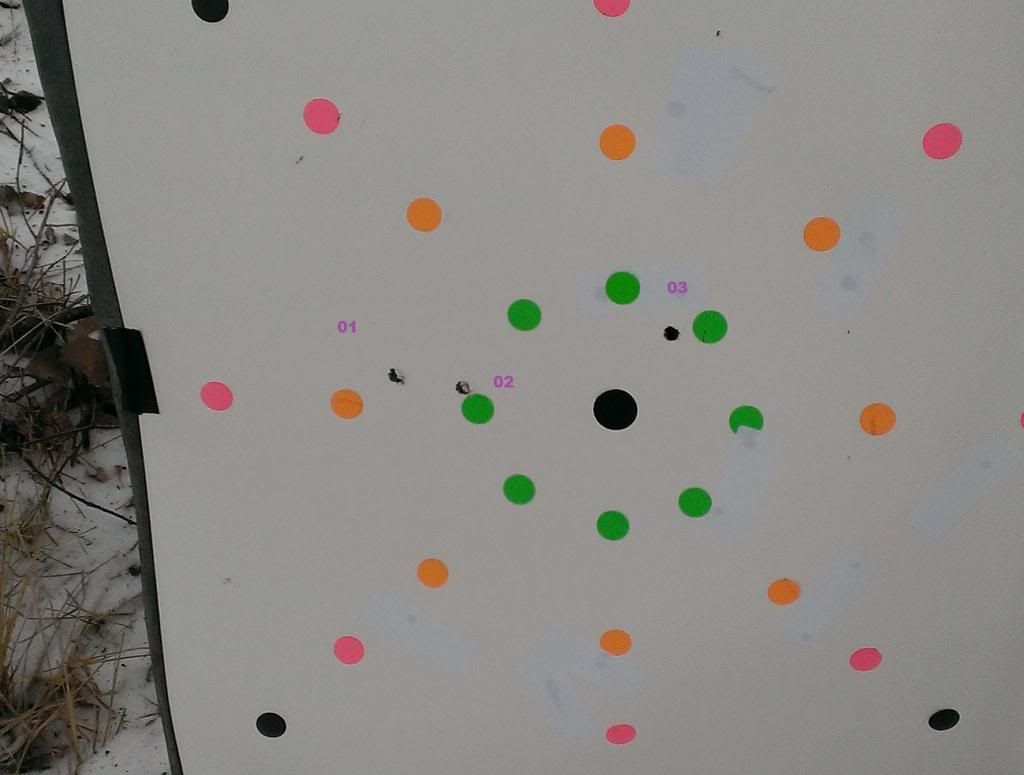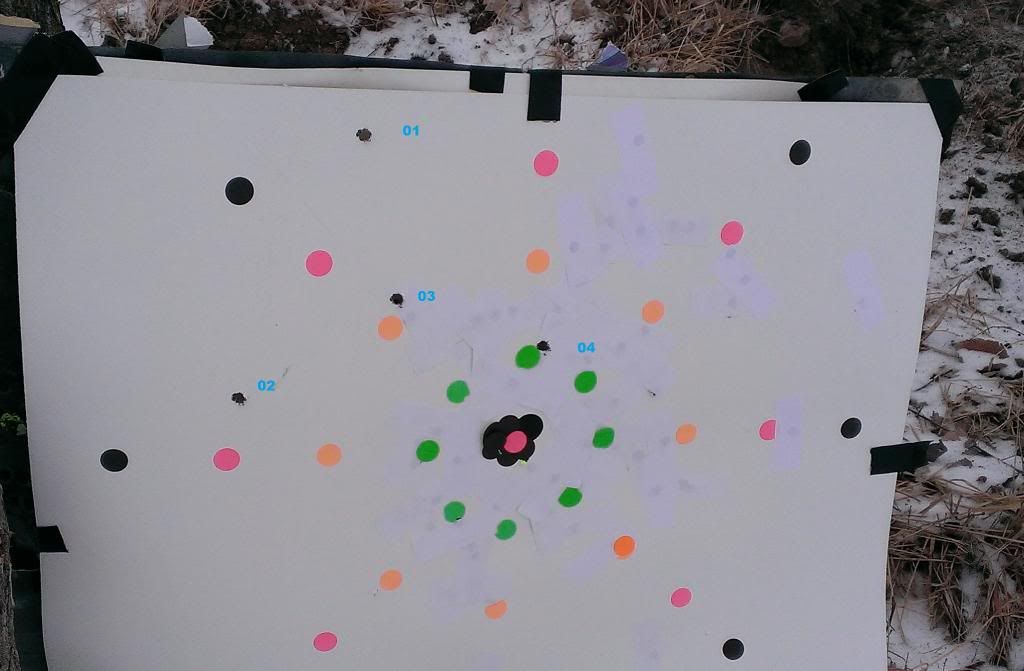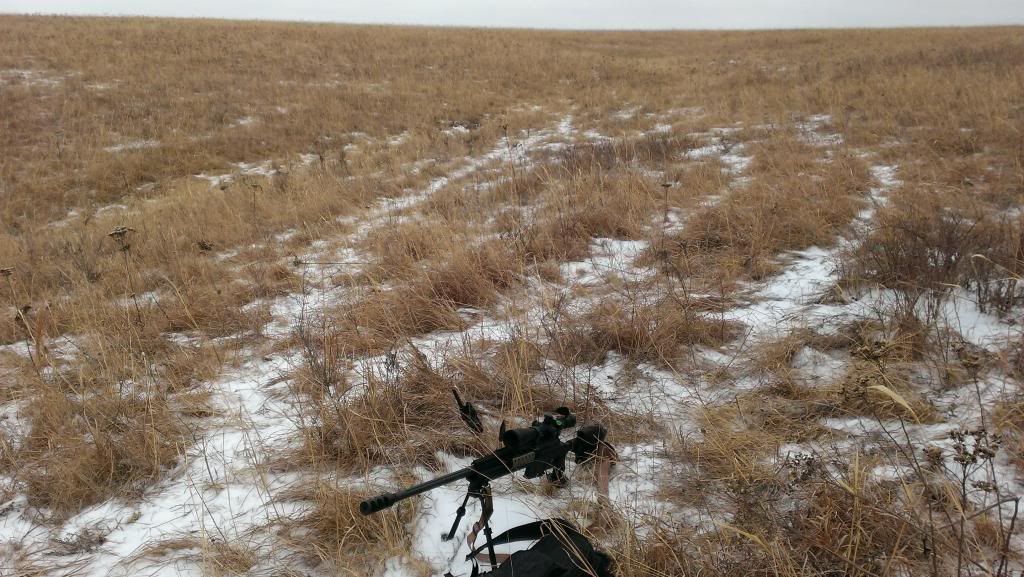2014-02-01
1300-1700
8 mph NW, Wind was varying between 300 and 30 degrees off bullet path.
20F
Overcast
Savage 110BA .338LM, 1.5pd trigger(stock), 20 MOA scope rail.
Leupold 6.5-20x M5 TMR FFP, both turrets and reticle are in mils on this scope. Vortex bubble, Leupold High rings.
HSM 250SMK 2890fps chrono'd in this rifle
Atlas Bipod with 3 inch extenders, making it a 9-12 inch bipod. At 600yds I set the left leg to 11 inches and the right leg to 12 inches as I was on a slope.
Tactical Interventions sling, the 1.45 inch width helps with the carries.
I had moved the scope back one rail to try to help with eye relief, but still struggling with eye relief for this setup. Dry firing in the house doesn't help much because I'm wearing different clothes and lying on different terrain and aiming down more in the field due to firing from higher elevations.
So first I fired 3 rounds at 325 to check zero.
Here is target pic:

Shots 01 and 02 were fired with no adjustments. Elevation was good but shot was 4.5 inches left, so held 0.5 right for shot 03. It was 2 inches high and 1 inch right. So based on these results, decided to head to 600yds. I would leave the Redfield spotting scope on the ground at the 325yd FP and go back and forth between the 600yd FP to shoot and the 325yd FP top observe fall of shot. The Redfield is not water proof and fogs up in these conditions and can barely see the bullet holes from 325.
So at 600yds fired 4 rounds.
Here is target pic:

Shot 01 held 2.2 up and .7 left as this was the AB program recommendation. POI was 9 inches high and 6 inches left. After the first shot, I noticed the vortex bubble had broken into 3 smaller bubbles. I agitated the rifle until they returned to one bubble. This first happened to me firing 7.62 rifle at -5F temp, so I thought it was a cold problem. But now I think it is a recoil problem. Subsequently this did not happen again on this shoot. It should be less likely once the fluid in the bubble gets cold, come to think of it.
Shot 02 held 2.0 up and .5 left. POI was 1.5 inches high and 9 inches left. The wind direction had veered around more to the front.
Shot 03 held 2.0 up and .25 left. POI round was 7 inches high and 4 inches left.
Shot 04 held 2.0 up and no windage adjustment. POI was 3 inches high and and dead center.
Here are some shots of the 600yd FP


I walked a total of 2700yds during this shoot, up and down hills, so got my exercise. The whole exercise took 4 hours, counting loading the buggy, driving to the area, patching the targets, then dismounting to proceed to the 325yd FP, the up to the 600yd FP, then back and forth for each round fired, then back to the targets for the pics, then RTB. You can see my walkie-talkie hanging on the sapling. I used this to check in with the wife. I loose all track of time when I'm doing these exercises. Right before I fired the 4th round from 600yds, I asked when I needed to be back. She was cooking a salmon dish for dinner, and she said NOW, and I said 20m. That's what it took to fire the round, return to 325, pack up, return to the buggy, return to the target area and then return to base. Usually, I'm the dinner cook, but tonight she wanted to do her salmon dish. We're still moving in to the ranch. Takes a while to figure out how to transition from a life time of city life to our new ranch life, but it is happening.
One aspect of these exerices is to learn to remain calm at all times. I consumed 2 bottles of water and 2 protein bars. I spread the consumption out and used them as rewards. I could look forward to another bit of protein bar and some water after each return to the 600yd FP. And while eating my bite and having some water, I would pull out the AB program (on my airplane mode droid) and do some calculations to decide what to fire next based on the observed fall of shot. This also gave time to catch breath after the climb back. But focus on being relaxed and methodical. I will accelerate the pace later, but for now, just trying to do this right. Despite using dish washing liquid on my safety glasses, I couldn't keep them on my face because they fogged up and froze up. I kept my balaclava over my nose as much as possible. The wind was pretty directly in my face most of the time. This has really bothered me in the past. I am learning how to deal with it. Can't let anything bother you if you want to hit the target.





